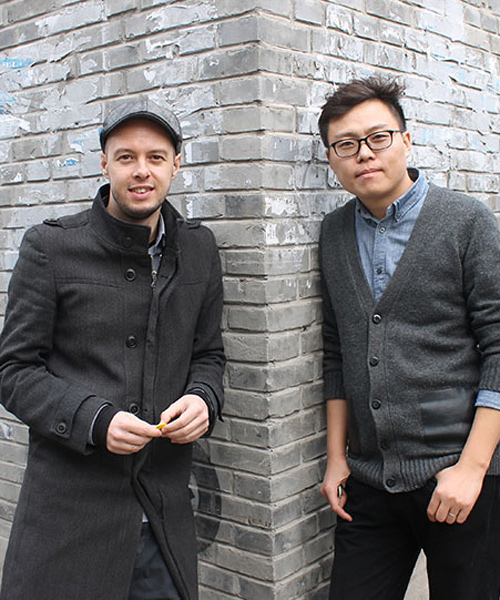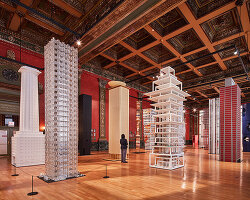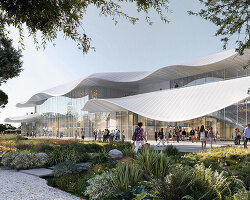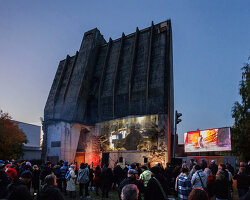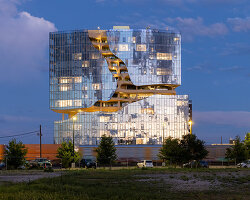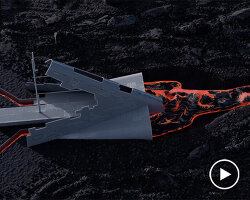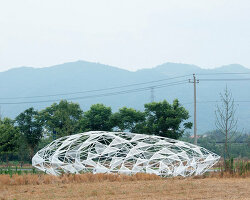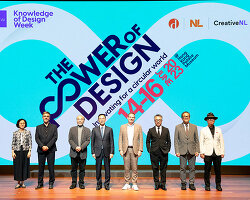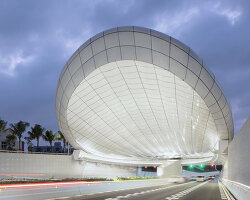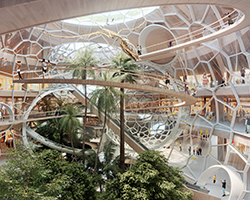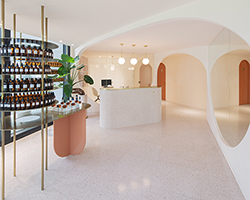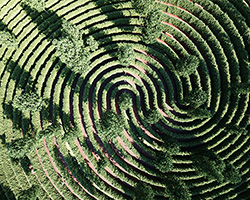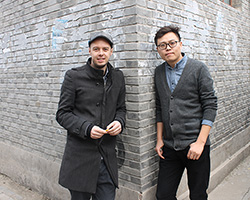penda is an inter-disciplinary team of creatives founded by vienna-based architect chris precht and beijing-based architect dayong sun. driven by a love for nature and its materials, the duo founded the firm in 2013 with the belief that architecture should serve as the bridge to connect nature, culture, and people. ‘by drawing different perspectives from western and eastern history, penda seeks the fundamentals in architecture and to interpret and integrate them into one cross-cultural design-language,’ explains the studio. ‘therefore we are interested in the questions of how life evolved throughout history, what influenced its process up to the present and what architecture can add to increase the quality of life for the future.’
designboom was in attendance at INTER_ACCION 2017, panama city’s 14th international architecture congress, where we spoke with chris precht about what inspires penda’s work, how architects can deal with topics like rapid urban growth, and his advice to today’s students and young designers. read the interview in full below.
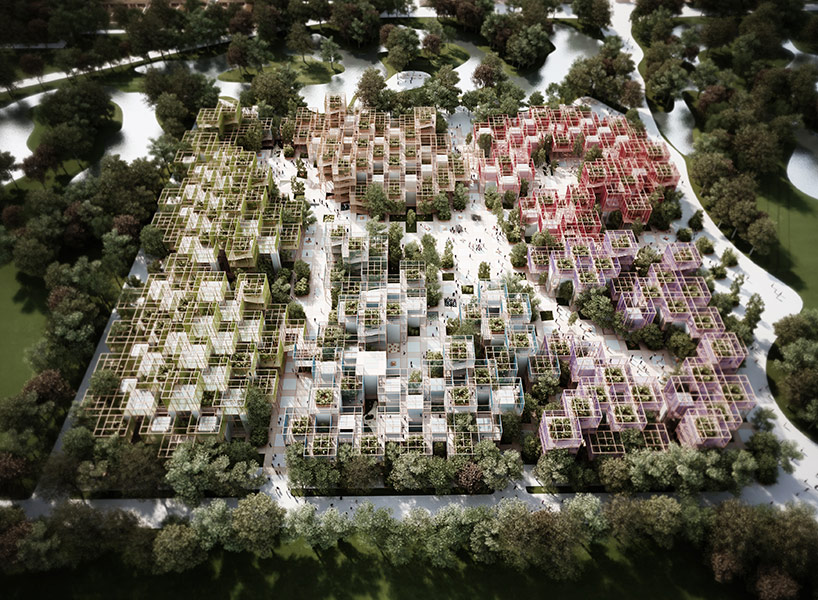
penda’s modular thousand yards pavilion to headline 2019 beijing expo (also main image)
image © penda | see the project on designboom here
designboom (DB): do you enjoy working as an architect — traveling around the world and learning from the approach of different cultures?
chris precht (CP): traveling the world is great if you have an international office, but the reason is not because I’m architect, but because I am a young professional. I think younger generations have become much more flexible. we are way more flexible than our parents ever were, and the next generation will be much more than us. the world is becoming more connected every day. I believe what is crucial is how an architect should really respond to this. everything becomes more adaptable – our cities are more flexible, yet more complex. things are changing constantly, but architecture remains a slow-paced profession.
for example, when a couple buys a new house, they must somehow plan how they want to live in 20 years — how many children will they have? will they have a dog? is the mother-in-law moving in? you have to think so far ahead and then buy a house which will accommodate all these future possibilities. this does not correspond with the flexibility our generation wants to have. so, maybe there’s a way in architecture we can have buildings that adapt to a certain living standard. when you have children, they grow and move out from home because they go to university, therefore you are going to sell parts of your house, or whenever you get a job offer someplace else your house can travel with you. architecture that really adapts to the flexible lifestyle of new generations. there are plenty of possibilities in this direction.
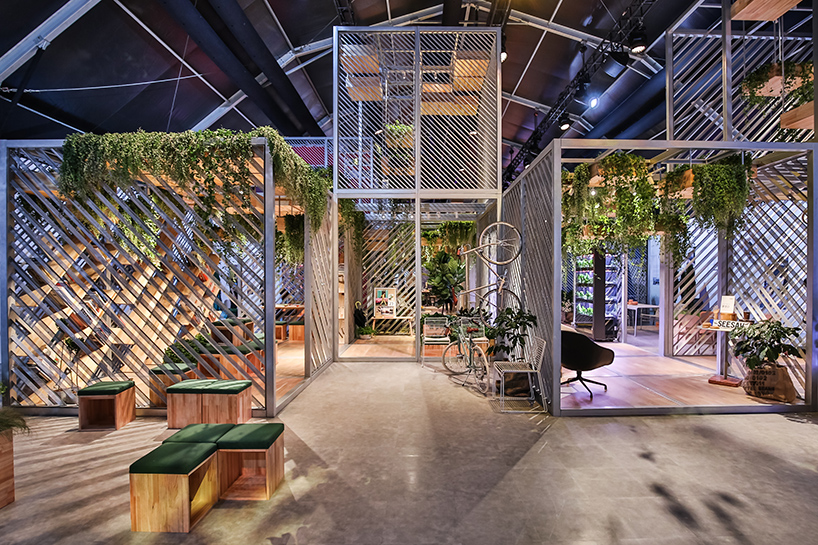
MINI LIVING + penda present ‘urban nest’ in shanghai: a living network of scaffolding
image courtesy of GQ and MINI | see the project on designboom here
DB: what happens when a ‘well-conceived design’ does not fit with a community’s local way of thinking?
CP: the intention of the architect is always great, until it clashes with the local lifestyle. there is this mixed-use building in beijing, for instance, designed as an inclusive project with a central public plaza, but is set within a very gated community. inside the gates, it is a very lively community and works very well. although the great intention, it would be amazing to see the building fulfill its potential as an integral project. then again, public space in china is very different to that in europe or USA. the intention of inclusivity would be really beautiful if they would go hand in hand with the local mindset, but politics and the media makes people afraid of refugees and migration, causing all these negative thoughts. somehow, the opinion of the public is being shifted to being frightened of the people, their cultures, integration and so forth. as architects we are very inclusive in our projects, we would like to have a good mix of people who are living in our buildings. I hope we grow into this direction and as architects, we have the huge responsibility to see this happen.
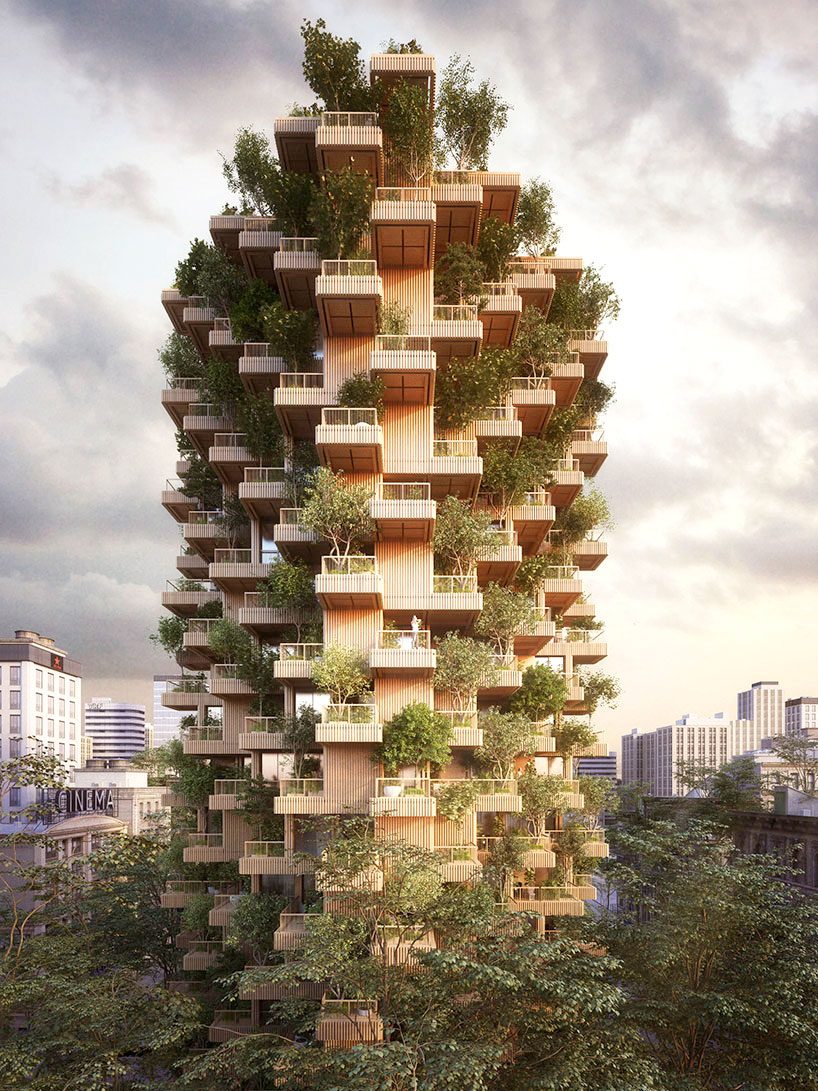
penda + tmber proposal for a timber tower bridges the gap between nature and culture
image © penda | see the project on designboom here
DB: how does architecture mold human behavior and health? how are architects responsible for designing spaces where people live day and night – whether it is the workspace, home, or public spaces?
CP: vitality is a huge topic in architecture. we would like to have more vital buildings in vital cities. we all somehow see what’s happening in china and india and other upcoming areas in the world — there is a lot of progress in terms of growth, but at the same time there is so much pollution, scandals and so forth. we as architects are part of the problem of creating pollution. nevertheless, there are alternatives. new materials are being used to build with lower carbon footprint, building with much less noise, waste, etc. so, there are ways to implement these new materials, such as cross-laminated timber, into our construction system to actually make this shift into a more ecological future.
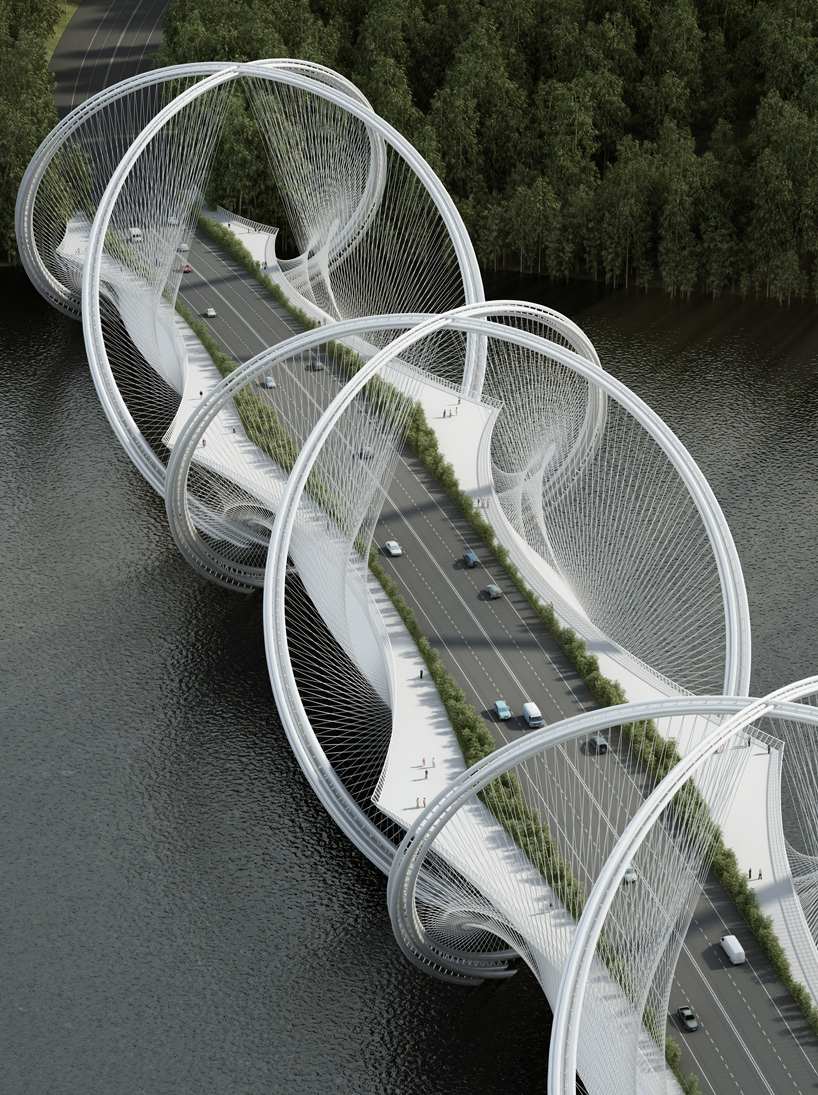
penda’s bridge for 2022 beijing winter olympics sculpted with double-helix arches
image © penda | see the project on designboom here
DB: how do you see the development and future in austria in terms of architecture?
CP: austria is coming from a wood construction background. the wood culture in austria is really big and our whole architecture history is based on wood as building material. it is no coincidence that CLT – cross laminated timber – was invented in austria. referring to the future of this material in high scale projects, I believe we are just at the starting point. in austria, CLT has been used over 30-40 years and mainly in households because it was really easy to build. but now, because it is cross laminated timber, it doesn’t shrink or swell – which is the biggest problem in wood construction. architects are now realizing it can be used in high rise buildings. considering the diverse contexts across the world, for example, in panama, there will be differences and limitations. mainly due to the transportation of the wood to the destinations. there are large CLT projects in australia and in canada. it relates to different climates as well. when it is very humid construction with wood is a bit difficult, but it can be protected.
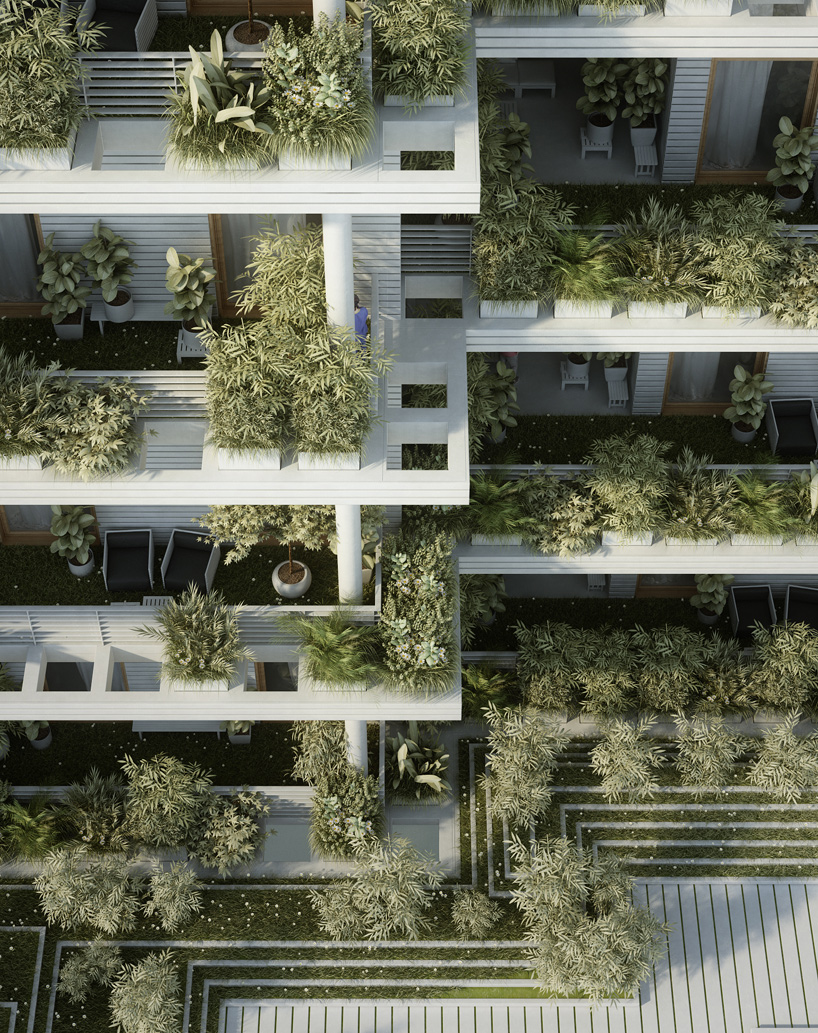
penda proposes green-filled sky villa residences in india
image © penda | see the project on designboom here
DB: what motivated you to pursue a career in architecture?
CP: I think it all goes back to how you grow up. I actually was a ski champion back then. I did ski jumping until I was 19 on a professional level. what is similar with architecture is that without knowing your tools and basics, you can’t do anything in ski jumping. so, it is a competition on a very high ground. everybody is basically talented, but it then relies on how hard you train to push forward. I think the passion you need for sport is the same as you need to create architecture. if you aren’t 100% committed to it, there might be other professions that suit you better. later on, I wanted to do something completely different and that’s when architecture came in. but I think it goes back to following my father as a carpenter — he worked a lot with wood and introduced me to it in the early years of my life.
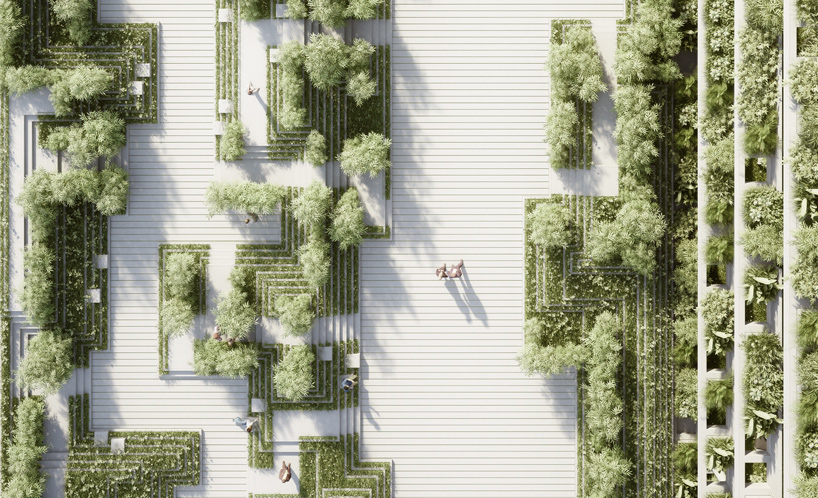
penda visualizes garden landscape referencing indian stairwells + water mazes
image © penda | see the project on designboom here
DB: does penda have any single design style or philosophy?
CP: I don’t think we have a style necessarily, nor would I like to have one. I believe if you only focus on certain forms or your principles, this limits the options of what you can do with the project. architecture is so vast that you should not limit yourself to generating a single ‘style’. I do think that we have certain parameters which we like to follow, for instance, understanding traditional materials and forms, and interpreting them in a new way, if it fits into context. we like to not just build for people, but also for nature. we give back a space for plants to grow on the buildings and provide the opportunity for people to grow their own garden, even in high rise and so forth.
every project has different parameters one must adapt to as an architect. I think it is good that we have a partner from austria – west – and another one from china – east – because the education, traditions and history in architecture are very different. the projects are not necessarily the end product of the partnership of two cultures, although, certain issues can be seen from different perspectives. ‘if all you have is a hammer, everything looks like a nail’. issues in architecture are more complex, so, the more tools you have the more freedom you will have.
![]()
penda develops pixelated wooden interior for chinese tech store
image by xia zhi | see the project on designboom here
DB: do you follow the work of any other architects in particular?
CP: I am truly passionate about architecture and getting inspired. I usually follow plenty of other architects and their work. one of my favorite architects is louis kahn, and from the more recent ones I enjoy what vo trong nghia architects is doing in its projects. I tend to follow how bjarke ingels – BIG – can communicate with his projects to a much wider audience, because I think that is one of the biggest problems of architects. there is so much passion involved in architecture that in architecture school you are just hanging out with other architecture students and you only learn how to communicate your project and thoughts to other students. but they will not turn out to be your clients or the public you will someday address. communicating a project to the public needs a different vocabulary and I think he does it perfectly.
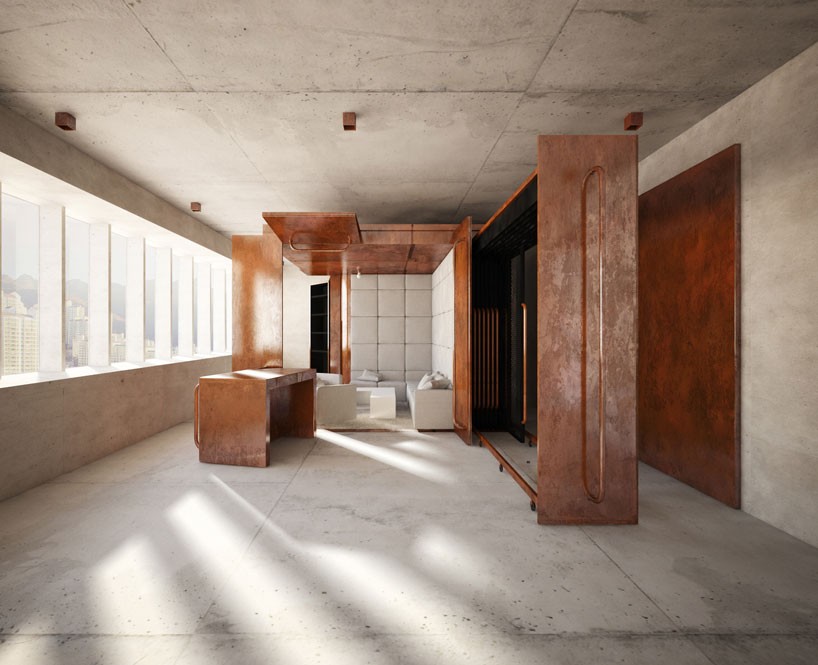
penda’s copper-clad box unfolds to serve as art storage space in hong kong
image © penda | see the project on designboom here
DB: what projects is penda currently working on?
CP: we are constantly working on projects. there are projects which have a client and you have to adapt to different parameters in order to find compromises with the people involved. however, in our office there are also projects where we start without a client because we think that in the future there will be a need for it. so, for example, the structure for the ‘one with the birds’ project started without a client and now clients are coming to us because they saw it and think it is something they want to build for themselves. this exercise of designing projects with no client helps to motivate the team and keeps the passion vivid. the best moments in architecture are probably when you are studying because you don’t have compromises. this passion is what makes architecture so great. if you don’t have a client you can focus on certain aspects or topics which are important to you and bring that concept to product.
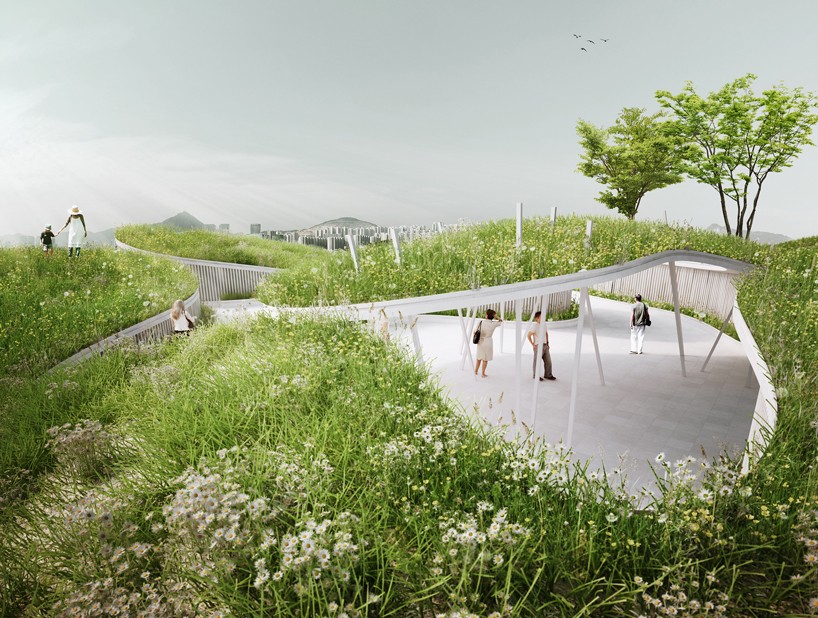
penda unveils undulating landscaped pavilion for china’s garden expo
image © penda | see the project on designboom here
CP (continued): at the moment, we are thinking and working a lot about how architecture and food can be combined. I think the future of food production is a very important topic. in the next 50 years we will consume more food than in the last 10,000 years combined. the world population will grow more and more, specifically in urban cities. I think future cities will need to have a vital role in growing their own food – eating local and growing local is something which is very important. I think, as humans, we lost the ownership of our food to a couple of big corporations. we somehow need to regain this ownership of our food so we can eat healthier. blessed are those who can grow and harvest their own food. we think of achieving this type of independence through architectural concepts that can integrate that. you can live in a skyscraper in the city, but you have access to your urban/vertical garden. we are thinking a lot about strategies like this and how to make architecture more vital.
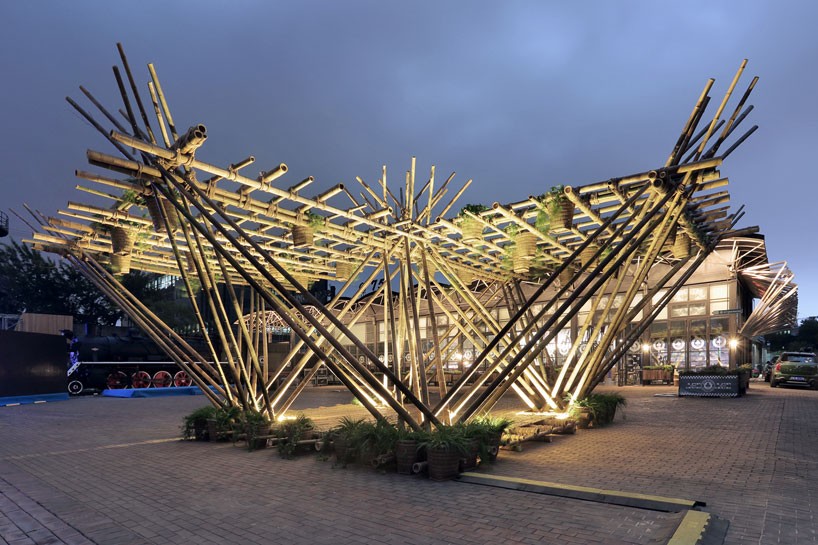
penda develops ‘rising canes’ pavilion made entirely out of bamboo and ropes
image by by xia zhi | see the project on designboom here
DB: what can architects do in response to increased urban growth?
CP: by 2050, around 70% of the world population will live in urban areas. worldwide, cities will undergo massive growth. if it grows too fast, then we can see the downside of cities such as pollution and waste. I think the building industry can do a lot, by promoting or designing with renewable materials — for example, bamboo and wood. then, also of course, legislative decisions must be made to support this. I think it need architects that have devotion, and on the other side, it needs politicians who can adapt quickly to a new building code. it also needs tech firms that are at the forefront of innovating new materials and ways of construction. in my opinion, pre-fab and modular systems that create variety are important for a clean and efficient adapting tool.
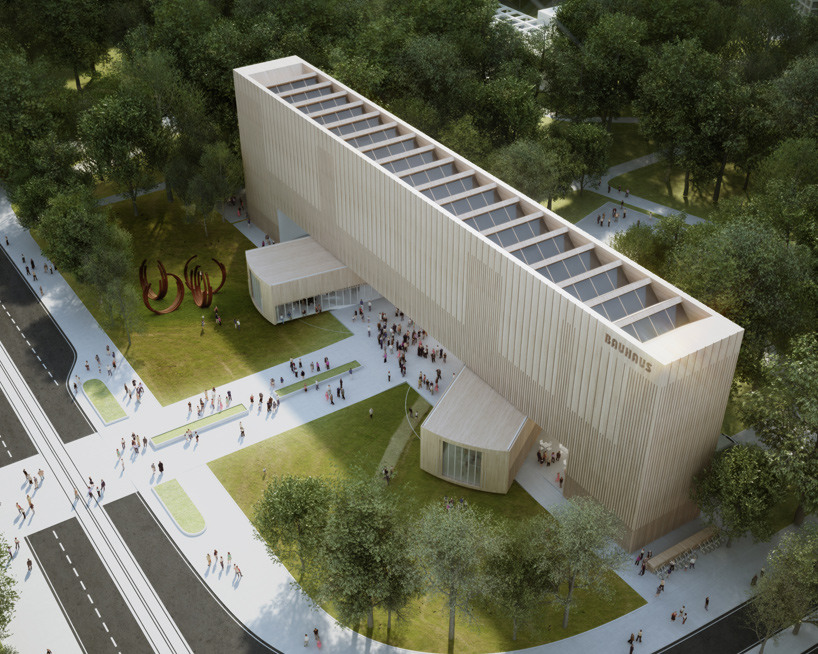
penda’s bauhaus museum proposal features a rotating ground floor
image © penda | see the project on designboom here
DB: do you have a dream project that you would like to work on?
CP: well, I would like to design the ski jumping hill in beijing for the olympic games — this would be my dream project! and, if I build it, I would definitely like to be the first person who jumps down. our most emblematic project is still to come. the studio is young and we have had several temporary projects.
DB: does the studio focus on awakening any emotions from the users when they enter your built projects?
CP: I hope that the architecture we design engages people. I hope it creates more vitality for the people who are living in it. I hope it encourages people, for example, to grow their own food, or, through design, engage people with the object or space.
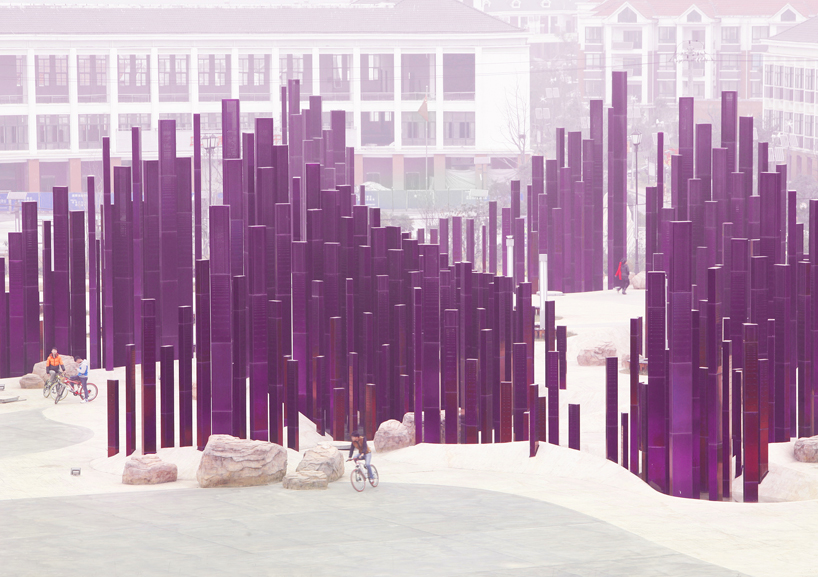
penda’s soundwave pierces the myrtle tree garden in china with 500 steel fins
image by xia zhi | see the project on designboom here
DB: is there any advice you recall being given about being a good architect?
CP: ‘sometimes you win, sometimes you lose’. this was very important for me as a sportsperson. there are some days where you aren’t good enough for winning, and I think the same applies for architecture. if you take everything too seriously and you have too big of an ego, where you need to win every competition or contract, then the job makes you sick. take some distance from what you’re doing from time to time. the passion we put into our work is so great that we involve our entire lives into that and this cannot be a healthy lifestyle. it would really be a pity if you blow out all of your passion during the first ten years of practicing. then, when you’re older you will not have any left. the first part is just learning as an architect and you need to keep a lot of passion for down the road — ‘rationalize your passion’.
DB: is there any advice you would like to give for young architects?
CP: probably the same. find yourself something outside of architecture, something that keeps your thoughts occupied when you’re not practicing. you cannot breathe architecture 24 hours a day. it is a beautiful thing to do, but you are working yourself into a ditch and that cannot be healthy for anyone. your motivation must be to use architecture and your passion in a responsible way.
happening this week! holcim, global leader in innovative and sustainable building solutions, enables greener cities, smarter infrastructure and improving living standards around the world.
architecture interviews (274)
penda (35)
precht (4)
PRODUCT LIBRARY
a diverse digital database that acts as a valuable guide in gaining insight and information about a product directly from the manufacturer, and serves as a rich reference point in developing a project or scheme.
